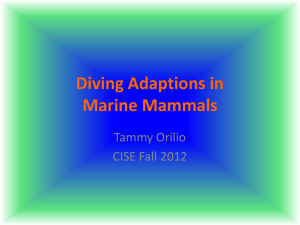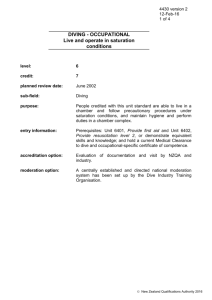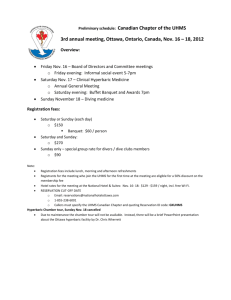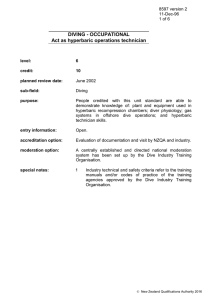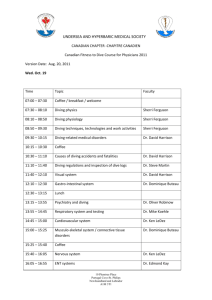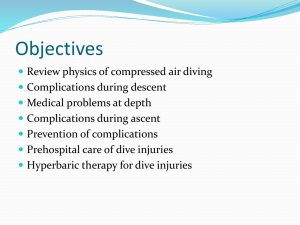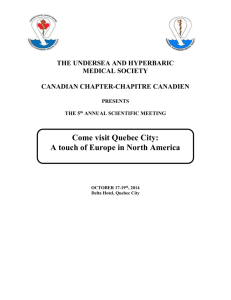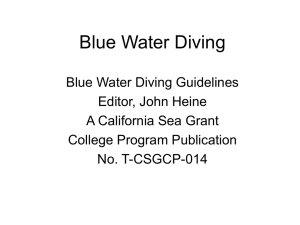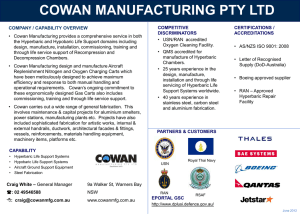Hyperbaric Chamber Overview 2014
advertisement
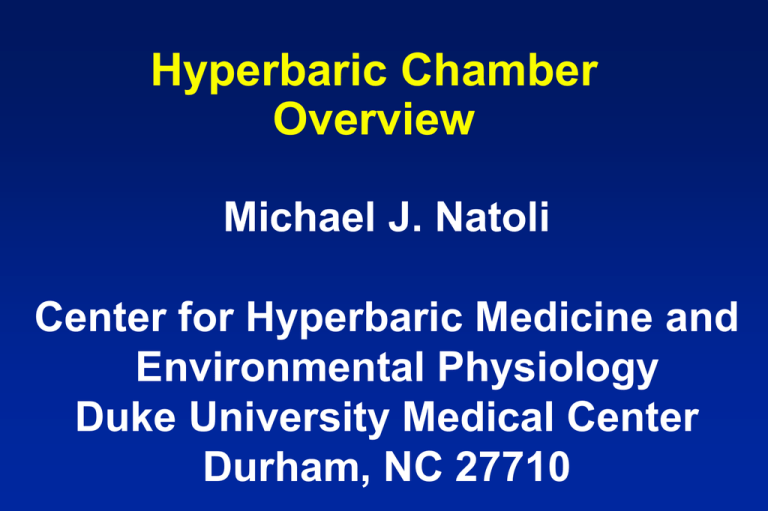
Hyperbaric Chamber Overview Michael J. Natoli Center for Hyperbaric Medicine and Environmental Physiology Duke University Medical Center Durham, NC 27710 Hyperbaric Surgery & Research at Duke, 1963-67 F.G. Hall Laboratory, 1968 Seven Multiplace Chambers Main Deck Second Deck Golf Foxtrot Golf Delta Echo Charlie Bravo Alpha Pipe Color Coding - US Navy Oxygen Nitrogen Helium Air Exhaust Vacuum Potable Water Fire system Alpha Chamber Compressors Air Storage Banks Control Console Don Bordeaux, 2005 Internal Environmental Control Pneumatic valves Muffler Cold water Heating / Cooling Coils Hot water Lubrication level Electric motor Blower Air flow Shaft seal Temperature indicator Thermistor External Environmental Control Blower Thermistor Need Picture Temperature controller Cold water CO2 absorbent Hot water Breathing Gas Systems BIBS Panel Liquid Oxygen and Nitrogen Oxygen Delivery Head tent Face mask Scott Duo-seal Single hose Overboard dump Plastic disposable Mouthpiece “T” piece Ambu-bag Ventilator Oxygen Delivery - Recirculating Head Tent Eduction Oxygen Eduction Line Purge Venturi 20 Purge Line 10 0 30 40 50 60 Sample Venturi Sample Line Bubbler Sodasorb Canister Ice Bucket Condensate Ice Water Drain Drain Latex Neckseal Headtents Oxygen Delivery - Single Pass Head Tent Overboard Dump Line Oxygen Patient Sample Line Oxygen Supply Regulator Oxygen Dump Regulator Latex Neckseal Oxygen Administration by Overboard Dump Mask Ventilator Eduction Manifold Description Outside Building Foxtrot 50 ft Delta Air Amplifier 1” pipe Charlie Bravo 3” pipe Alpha 4 ft2 Chamber Exhaust Duct Manifold Inlet Fire Suppression System Relief valve 200 psig reg. check valve Muffler OFF Fire Suppression Tank 450 psig air Pneumatic valve Air mask Overhead sprinklers Manual Pump Level indicators ON Drain Hand-held hose Nitrogen Purge Plantronics Headset Telex TR-200 Wireless Intercom Two-way Mic/Speaker Box Sound-powered Phone Breathing Gas Analysis Chamber Atmosphere O2 (20.5% - 23.5%) CO2 (< 1.0% SEV) Patients O2 (> 98.0%) CO2 ( < 1.0% SEV) Breathing Gas Analysis Patient Monitoring Monitoring Connections Inside the Chamber Defibrillator Transcutaneous Oxygen Monitors Suction Medical Lock Hyperbaric Oxygen Therapy Program • Each year, 300 patients breathe 100% oxygen at about 2 times atmospheric pressure • 13 UHMS approved conditions including air embolism, decompression sickness, CO poisoning, gas gangrene, problem wounds 35 Education Program • Graduate students • Intern & resident training • 12 month Diving & Hyperbaric Medicine Fellowship (2 per year) • Semester course in the “Physiology & Medicine of Extreme Environments” 36 Research Program Supporting agencies National Heart, Lung, Blood Institute National Aviation & Space Agency Navy, Army, Air Force National Oceanographic & Atmospheric Administration Divers Alert Network Commercial diving companies 37 Saturation Diving to 2,250 Feet (1970s-80s) 38 Right Heart Bubbles RV RA LV LA 39 40 Flying After Diving Recreational Diving (Divers Alert Network) High Altitude Parachuting (Army Special Forces) 41 ‘Combat Edge’ Positive Pressure Suit 42 NASA Extravehicular Activity (EVA) 43 O2 Breath-Hold Diving 44 Differential Gene Expression Affymetrix U133A chip measures 14,000 genes per sample Response to decompression stress (ONR) Genetic predisposition to IPE (NAVSEA) 45 Immersion Pulmonary Edema Sudden dyspnea, hemoptysis during swim/dive. Can be fatal Divers, triathletes, Navy trainees (NEDU, BUD/S) Pathophysiology may be exaggerated increase in pulmonary vascular pressures during immersed exercise in cold water 46 Biochemical Modification of Susceptibility to Mountain Sickness (DARPA) Can adaptation to altitude be accelerated by a combination of several drugs? Can exercise performance be improved? Increase systemic blood flow without increasing pulmonary blood flow? Initial tests in mice, then humans 47

